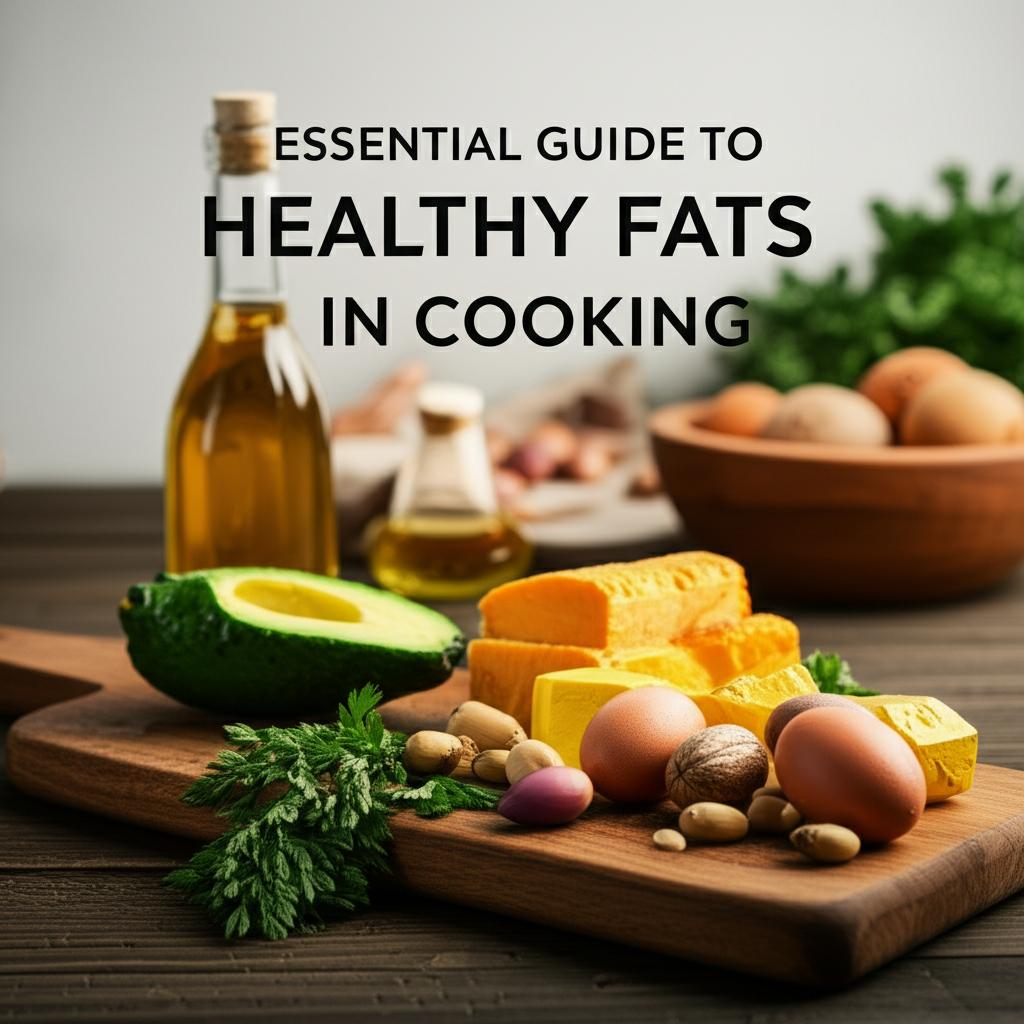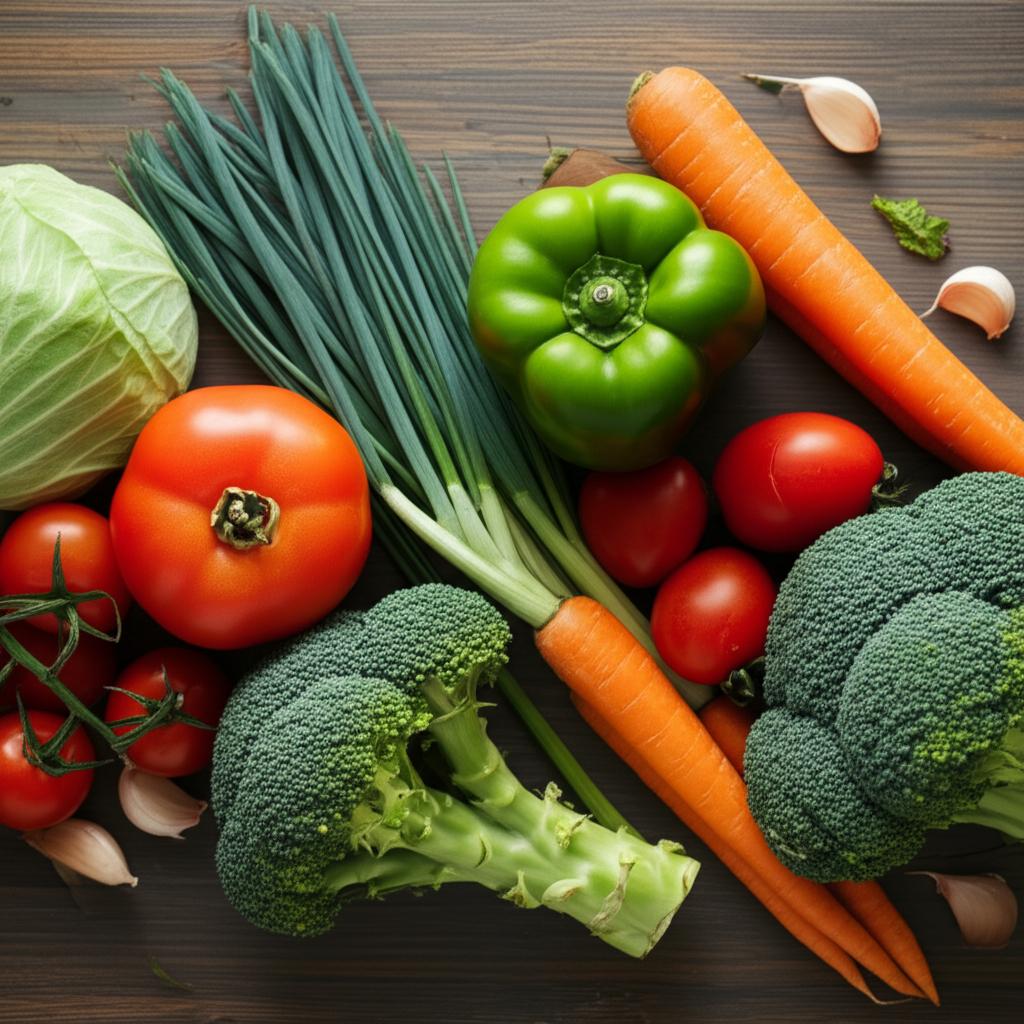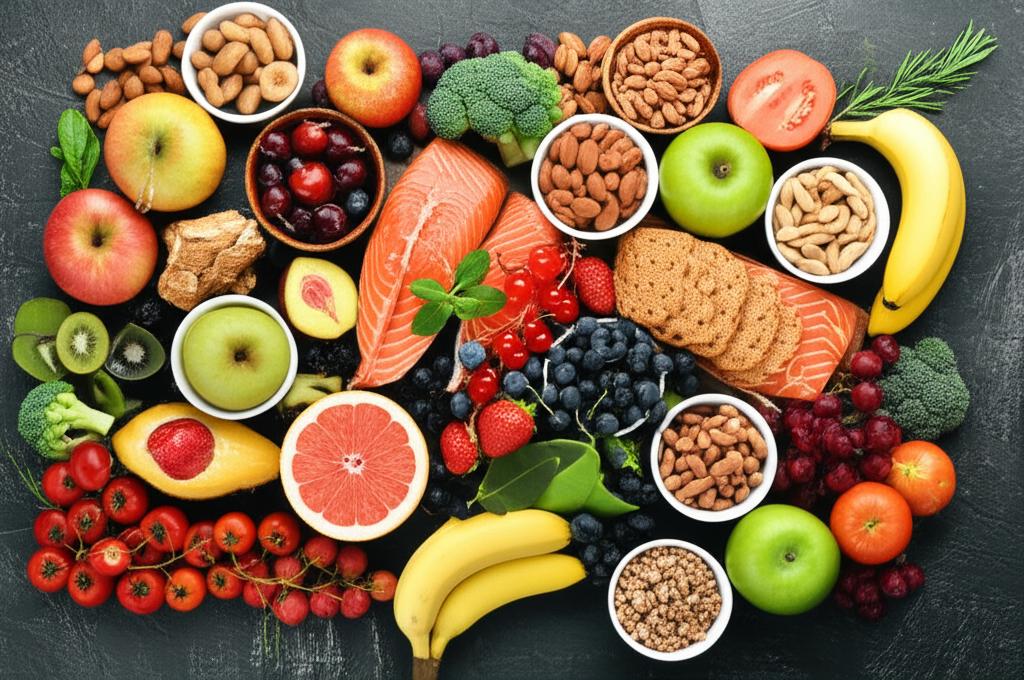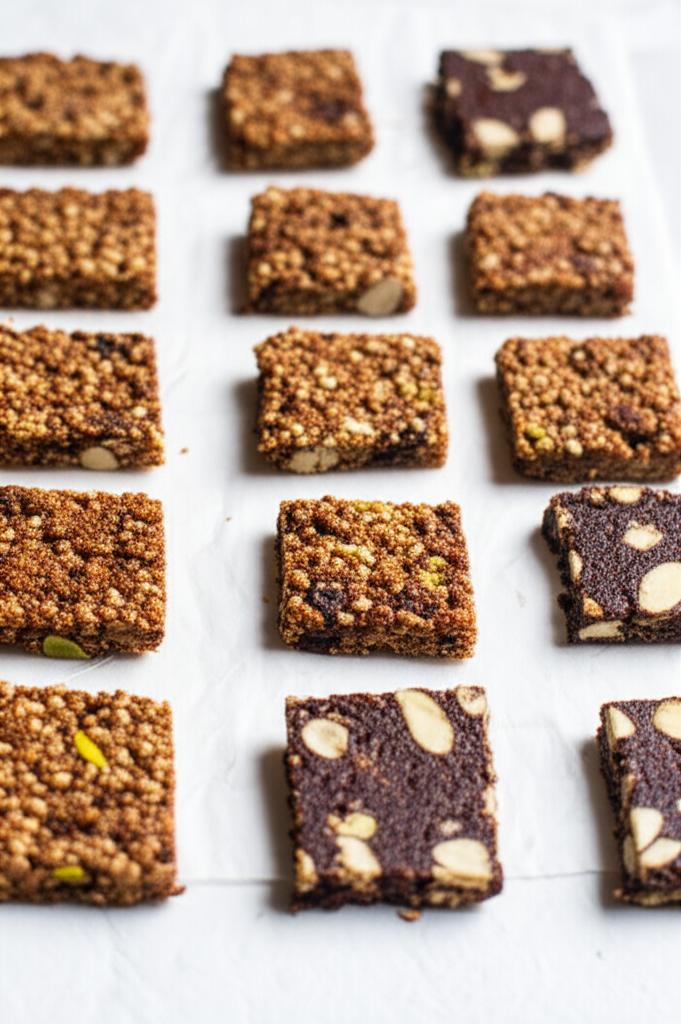
The Essential Guide to Healthy Fats in Cooking: Unlock Flavor & Nutrition
- AOZITA 17oz Glass Olive Oil Bottle Dispenser – 500ml Green Oil and Vinegar Cruet with Pourers and Funnel – Olive Oil Carafe Decanter for Kitchen
- TrendPlain 16oz/470ml Glass Olive Oil Sprayer for Cooking – 2 in 1 Olive Oil Dispenser Bottle for Kitchen Gadgets and Air Fryer Accessories, Salad, BBQ – Black
- YRRAMATE 16oz/470ml Glass Olive Oil Sprayer for Cooking with Stickers, 2 in 1 Oil Dispenser for Kitchen Gadgets, Food Grade Premium Spray Bottle with Portion Control for Salad, Frying, BBQ (Black)
For years, fat got a bad rap, often seen as the enemy of a healthy diet. But the truth is, not all fats are created equal! In fact, healthy fats are absolutely essential for our bodies, playing vital roles in everything from hormone production and brain function to nutrient absorption and keeping us feeling full and satisfied.
The key isn’t to avoid fat, but to understand which fats are beneficial and how to use them wisely in your cooking. This comprehensive guide will demystify healthy fats, empower you with culinary knowledge, and help you infuse your meals with both delicious flavor and incredible nutrition. Let’s dive in!
Why Healthy Fats Matter for Your Plate & Your Health
Before we get to the kitchen, let’s quickly understand why incorporating healthy fats is such a game-changer:
- Nutrient Absorption: Many essential vitamins (A, D, E, K) are fat-soluble, meaning your body needs fat to absorb them properly. Think of it: that healthy salad needs a little healthy fat to unlock its full potential!
- Energy Source: Fats are a concentrated source of energy, providing sustained fuel for your body and brain.
- Cell Function: Fats are fundamental building blocks of cell membranes, crucial for every cell in your body.
- Hormone Production: Healthy fats are essential for the production of many hormones, including those that regulate metabolism and mood.
- Satiety & Flavor: Fats add richness, texture, and flavor to food, helping you feel satisfied and reducing the urge to overeat.
Understanding the Stars: Your Healthy Fat Lineup
Not all fats are created equal, and knowing the main types will help you make smarter choices.
1. Monounsaturated Fats (MUFAs)
Often hailed as heart-healthy heroes, MUFAs are liquid at room temperature and start to solidify when chilled. They are known for their anti-inflammatory properties and their ability to improve cholesterol levels.
- Key Sources: Extra Virgin Olive Oil, Avocado Oil, olives, avocados, almonds, cashews, peanuts.
- Best Uses: Great for medium-heat cooking, sautéing, roasting, salad dressings, and dipping.
2. Polyunsaturated Fats (PUFAs)
These fats are also liquid at room temperature and remain liquid when chilled. They include the crucial Omega-3 and Omega-6 fatty acids, which our bodies cannot produce on their own.
- Key Sources:
- Omega-3s: Flaxseed oil, chia seeds, walnuts, fatty fish (salmon, mackerel, sardines).
- Omega-6s: Sunflower oil, corn oil, soybean oil, walnuts, pumpkin seeds. (While essential, consume Omega-6s in moderation and aim for a good balance with Omega-3s).
- Best Uses:
- Omega-3-rich oils (like flaxseed oil) are best for low-heat or no-heat applications like salad dressings or drizzling after cooking, as they are sensitive to high heat.
- Other PUFAs like sunflower oil can be used for moderate cooking, but prioritize oils with higher smoke points for high-heat methods.
3. Saturated Fats (in Moderation & with Nuance)
While often demonized, certain saturated fats, particularly those from less processed sources, can be part of a healthy diet in moderation. They are solid at room temperature. The key here is quality and balance.
- Key Sources: Coconut Oil, Grass-fed Butter, Ghee (clarified butter), fatty cuts of meat, full-fat dairy.
- Best Uses: Coconut oil, butter, and ghee are excellent for higher-heat cooking due to their stability. Use them sparingly as part of a balanced fat intake.
The Essential Guide to Cooking with Healthy Fats: Step-by-Step
Choosing the right healthy fat is just the beginning. Knowing how to use it is where the magic happens!
Step 1: Understand the Smoke Point – Your Culinary Compass
This is perhaps the most crucial concept when cooking with fats. The smoke point is the temperature at which an oil or fat begins to smoke continuously, breaking down and releasing harmful free radicals and losing its beneficial properties. Using an oil above its smoke point not only harms your health but also ruins the flavor of your food.
Your Go-To Smoke Point Guide:
- High Smoke Point (400°F+): Ideal for Frying, Roasting, Searing
- Avocado Oil: Very high smoke point (up to 520°F). Neutral flavor. Excellent for almost any cooking method.
- Refined Coconut Oil: High smoke point (around 400°F). Neutral flavor, unlike its unrefined counterpart.
- Ghee (Clarified Butter): High smoke point (485°F). Rich, buttery flavor. Lactose and casein-free.
- Medium Smoke Point (325°F – 375°F): Great for Sautéing, Baking, Pan-Frying
- Extra Virgin Olive Oil (EVOO): Smoke point ranges from 350-410°F depending on quality. Wonderful for most everyday cooking, including sautéing vegetables, light pan-frying, and baking. Its distinct flavor can enhance dishes.
- Unrefined Coconut Oil: Smoke point around 350°F. Distinct coconut flavor.
- Low/No Heat Applications (Below 325°F): Perfect for Dressings, Drizzling, Finishing
- Flaxseed Oil: Very low smoke point (225°F). Rich in Omega-3s. Never use for cooking. Best for salad dressings, smoothies, or drizzling over finished dishes.
- Walnut Oil: Low smoke point. Nutty flavor.
- Extra Virgin Olive Oil (EVOO): While it can be cooked with, its delicate flavor and beneficial compounds truly shine when used as a finishing oil over salads, soups, or grilled vegetables.
How to Use This Step: Before you start cooking, ask yourself: “How hot will my pan get?” Then, choose the fat that matches that heat level.
Step 2: Master Portion Control
Even though healthy fats are good for you, they are calorie-dense. A little goes a long way.
- For cooking: Start with just 1-2 tablespoons of oil or fat for most dishes. You can always add a little more if needed.
- For dressings: Measure your oil for salads. A typical serving is 1-2 tablespoons.
- For baking: Follow recipe instructions carefully.
Tip: Using non-stick pans can help you reduce the amount of oil needed for cooking.
Step 3: Proper Storage is Key
Heat, light, and air are enemies of healthy fats, causing them to go rancid (spoil) faster.
- Store oils in a cool, dark place, away from the stove or direct sunlight.
- Keep bottles tightly sealed to prevent oxidation.
- Refrigerate delicate oils like flaxseed oil after opening to extend their freshness.
- Pay attention to expiration dates and trust your nose – if an oil smells “off” or rancid, discard it.
Step 4: Incorporate Beyond Oils
Remember, healthy fats aren’t just found in bottles!
- Avocado: Add slices to salads, sandwiches, or mash for guacamole.
- Nuts & Seeds: Sprinkle on oatmeal, yogurt, salads, or snack on a small handful. Think almonds, walnuts, chia seeds, flax seeds, pumpkin seeds.
- Fatty Fish: Aim for 2-3 servings of salmon, mackerel, or sardines per week.
- Nut Butters: Choose natural nut butters (peanut, almond, cashew) with minimal added sugar and oils.
General Tips for Success with Healthy Fats
- Read Labels: When buying oils, look for terms like “cold-pressed,” “unrefined,” or “extra virgin” where appropriate, indicating less processing and more preserved nutrients.
- Variety is the Spice of Life: Don’t stick to just one type of fat. Incorporating a range of healthy fats ensures you get a broader spectrum of beneficial fatty acids.
- Don’t Fear Fat: Embracing healthy fats can lead to more satisfying meals, better nutrient absorption, and improved overall health.
- Quality Over Quantity: Always opt for high-quality, minimally processed healthy fats.
Common Mistakes to Avoid
- Using the Wrong Oil for High Heat: This is the most common mistake. Don’t use extra virgin olive oil or flaxseed oil for deep frying. You’ll destroy their beneficial compounds and create harmful ones.
- Over-Consuming Even Healthy Fats: While good for you, fats are calorie-dense. Excessive intake, even of healthy fats, can lead to weight gain. Moderation is key.
- Improper Storage: Leaving oils in clear bottles on a sunny countertop will drastically shorten their shelf life and lead to rancidity. Always store in a cool, dark place.
- Fearing All Fats: Falling for old dietary myths and cutting out all fats can lead to nutrient deficiencies and lack of satiety. Embrace healthy fats!
- Ignoring “Hidden” Unhealthy Fats: Be mindful of processed foods, baked goods, and fast food, which often contain unhealthy trans fats or an excess of refined vegetable oils. Focus on whole, unprocessed ingredients.
Your Kitchen, Your Healthier Future
Congratulations! You’re now equipped with the essential knowledge to confidently navigate the world of healthy fats in your kitchen. By understanding smoke points, choosing diverse sources, and practicing mindful portion control, you’ll not only enhance the flavor of your cooking but also significantly boost the nutritional value of every meal.
Embrace these essential fats, and enjoy the journey to more delicious, nourishing, and satisfying cooking!
- AOZITA 17oz Glass Olive Oil Bottle Dispenser – 500ml Green Oil and Vinegar Cruet with Pourers and Funnel – Olive Oil Carafe Decanter for Kitchen
- TrendPlain 16oz/470ml Glass Olive Oil Sprayer for Cooking – 2 in 1 Olive Oil Dispenser Bottle for Kitchen Gadgets and Air Fryer Accessories, Salad, BBQ – Black
- YRRAMATE 16oz/470ml Glass Olive Oil Sprayer for Cooking with Stickers, 2 in 1 Oil Dispenser for Kitchen Gadgets, Food Grade Premium Spray Bottle with Portion Control for Salad, Frying, BBQ (Black)
FAQ
Q. What exactly are “healthy fats” and why are they essential for cooking?
A. Healthy fats primarily refer to monounsaturated fats (MUFAs) and polyunsaturated fats (PUFAs), including Omega-3 and Omega-6 fatty acids. They are essential because our bodies cannot produce them, yet they are crucial for energy, nutrient absorption (especially fat-soluble vitamins A, D, E, K), hormone production, cell growth, and reducing inflammation. Incorporating them into cooking ensures these vital nutrients are part of your daily diet.
Q. Which specific healthy fats are recommended for everyday cooking and what are their best uses?
A. For high-heat cooking like frying or roasting, avocado oil is excellent due to its high smoke point. Extra virgin olive oil is ideal for sautéing, baking, salad dressings, and finishing dishes, but it has a lower smoke point, so it’s best for medium heat or below. Coconut oil can be used for moderate-heat cooking and adds a unique flavor. Ghee (clarified butter) is also a good option for high-heat cooking with a rich, buttery taste, as milk solids have been removed.
Q. Are there any common cooking fats that I should be cautious about or avoid, even if they’re marketed as healthy?
A. Yes, it’s wise to be cautious about highly refined vegetable oils like corn, soybean, cottonseed, and some canola oils, especially if they are heavily processed, as their production can involve high heat and chemical solvents that may damage their delicate fatty acids. Trans fats, often found in hydrogenated or partially hydrogenated oils, should be avoided entirely due to their detrimental effects on heart health. Always check labels for processing methods and hydrogenated fats.
Q. How do I choose the right healthy fat for different cooking methods, such as high-heat frying versus low-heat sautéing or baking?
A. The key factor is the fat’s “smoke point,” which is the temperature at which it starts to burn and break down, producing harmful compounds and undesirable flavors. For high-heat methods (frying, searing, roasting), choose fats with a high smoke point, like avocado oil, ghee, or refined coconut oil. For medium-heat sautéing, baking, or dressings, extra virgin olive oil, unrefined coconut oil, or butter work well. Always match the fat to the cooking temperature to preserve its health benefits and flavor.
Q. Can I reuse cooking oil, and if so, how many times and under what conditions?
A. Reusing cooking oil is generally not recommended, especially for deep-frying, as repeated heating degrades the oil, forming harmful compounds and free radicals. If you must reuse oil, limit it to 1-2 times, ensure it hasn’t reached its smoke point or darkened significantly, and strain it through a fine-mesh sieve or cheesecloth after each use to remove food particles. Store it in a sealed, dark container in a cool place, and discard it if it develops a rancid smell, looks cloudy, or foams excessively.
Q. How should I store healthy fats to ensure they maintain their quality and nutritional benefits?
A. Proper storage is crucial to prevent oxidation and spoilage. Healthy fats should be stored in cool, dark places, away from direct sunlight and heat, which can accelerate rancidity. Opaque, airtight containers are best to protect them from light and air exposure. Some oils, like flaxseed oil, are very delicate and should be refrigerated after opening to extend their shelf life. Always check the “best by” date and the oil’s smell for freshness before use.
Q. What’s the difference between refined and unrefined healthy oils, and which is better for cooking?
A. Unrefined oils are minimally processed, often cold-pressed, retaining more of their natural nutrients, flavor, and aroma. Examples include extra virgin olive oil and unrefined coconut oil. They generally have lower smoke points. Refined oils undergo more extensive processing (e.g., heating, bleaching, deodorizing) to remove impurities, neutralize flavors, and increase their smoke point, making them more suitable for high-heat cooking but often at the cost of some nutrients and flavor. The “better” choice depends on your cooking method and desired flavor profile.


